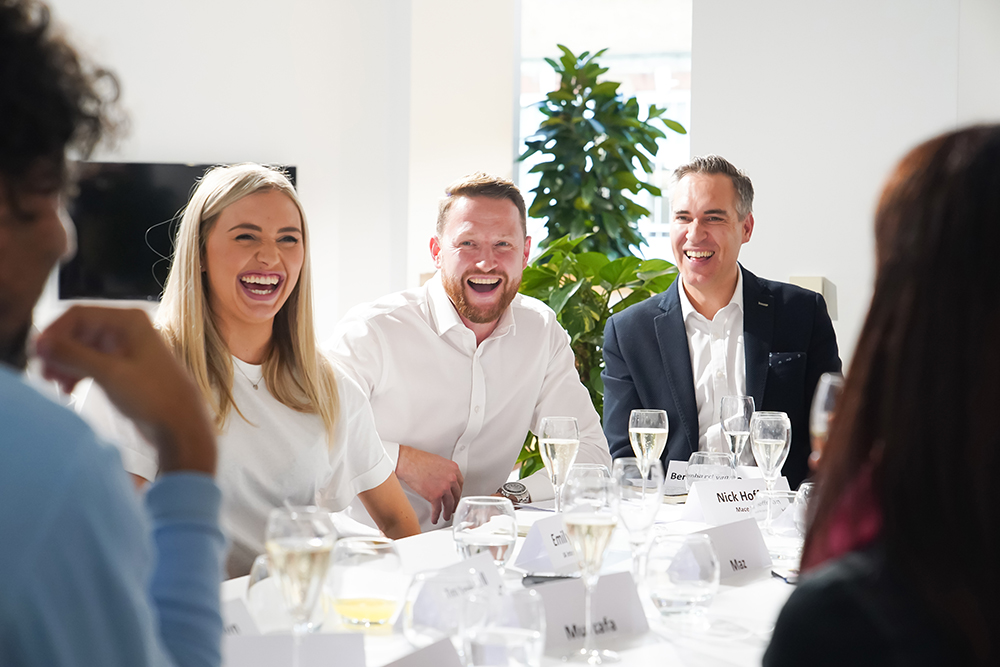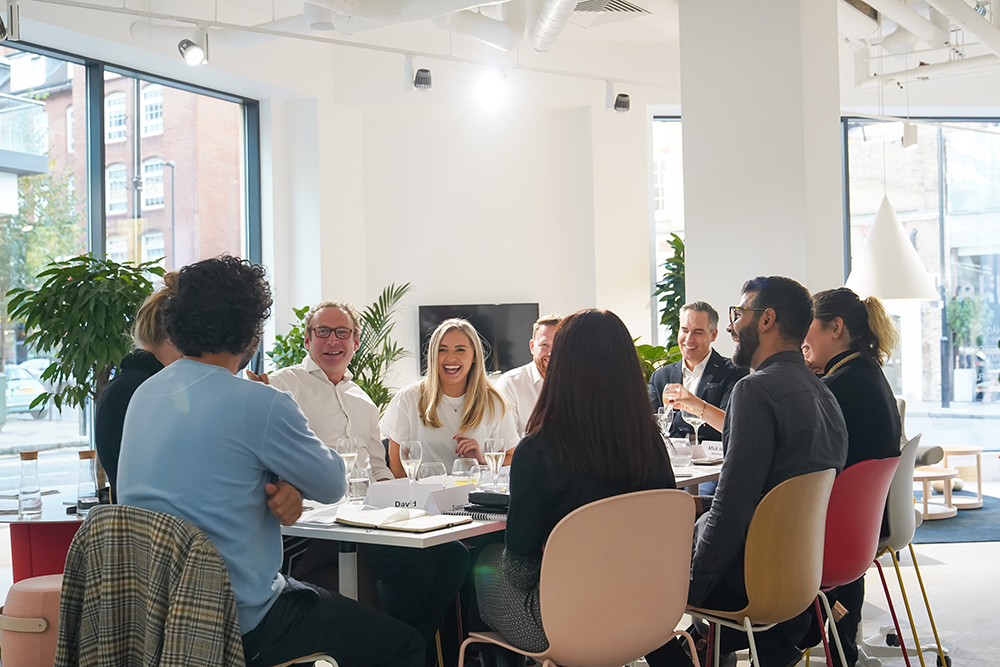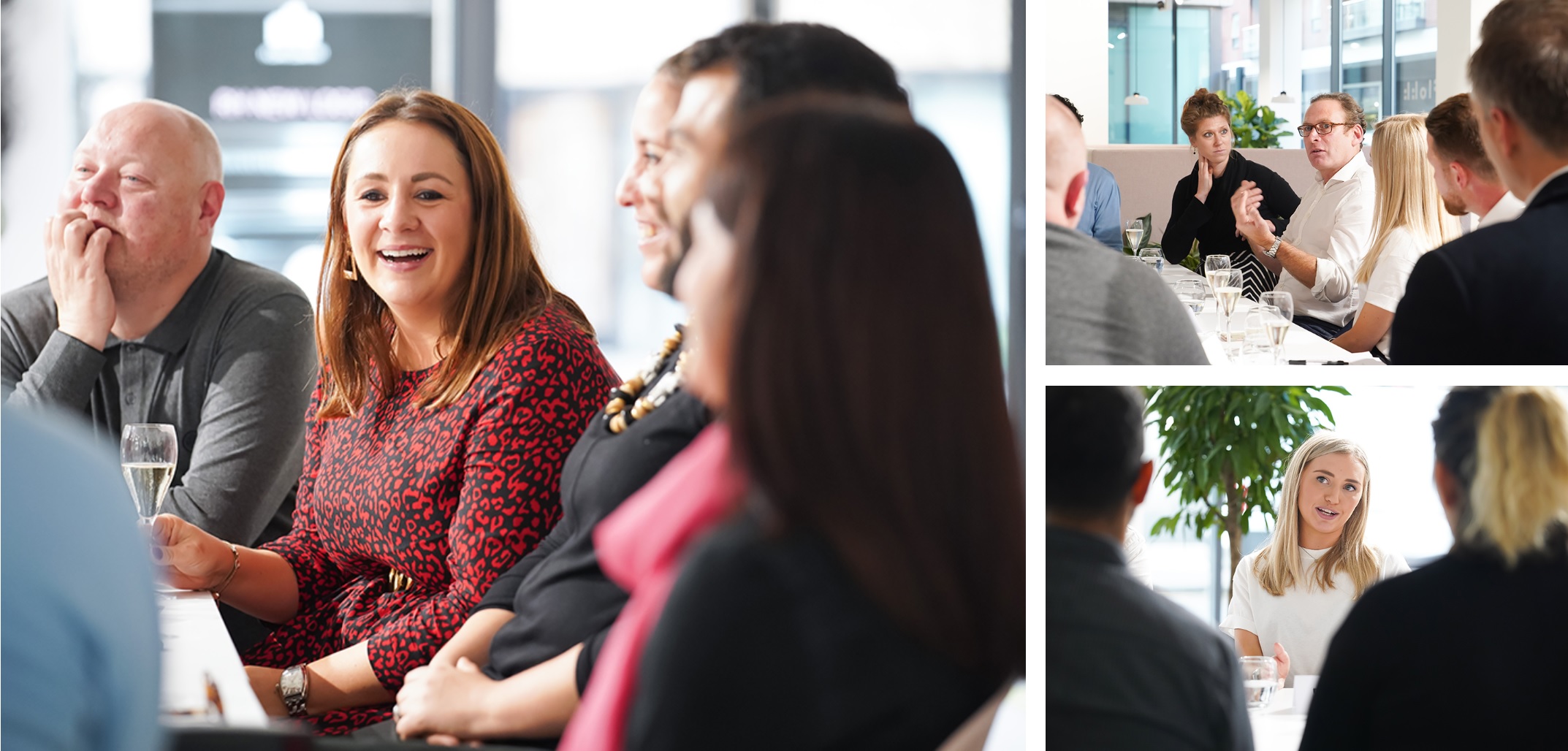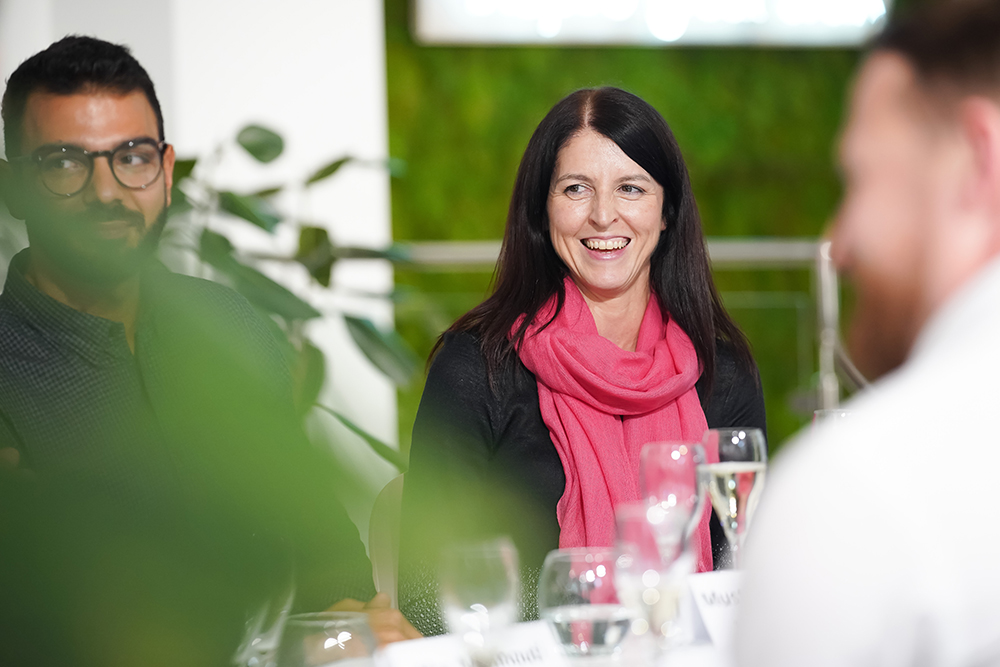
Designing workplaces for collaboration - a roundtable discussion with Mix Interiors
What is the optimum level of communication and how can a workplace be created to satisfy this? With the help of a wonderful roundtable cohort, we focus on the subject of creating the optimum level of collaboration.

In a world where it has never been easier to communicate, the likelihood of communication breakdown never seems greater. It is widely believed that increased communication leads to better results. But is this true?
What is the optimum level of communication and how can a workplace be created to satisfy this? With the help of a wonderful round table cohort, we focus on the subject of creating the optimum level of collaboration.

Stand first – On a personal level, if you had to choose just one, would you prefer to work in open plan or in your own quiet, individual space?
Sarah: I would say open plan all day long – with a coffee shop if possible! I grew up in the States working in open plan. I don’t even like headphones in the office. You’ll never see me in headphones in the office because I believe you learn by osmosis and the environment around you.
Tim: Open plan!
Emily: I would be in a cubicle with headphones on! Maybe that says more about me…I can be easily distracted.
Nick: Definitely open plan for me. I like the energy of sitting around other people – but with the proviso that there is space to get away and work quietly.
Bernhard: My preference is to be amongst my team – to listen to the daily needs and requirements. Again, at the same time, I do need space where I can sit and close myself off.

Charlotte: My preference is definitely open plan – as long as it is comfortable.
Maz: I’m very much open plan – I like my tunes and I like noise. I do know that my colleagues would occasionally like to push me into a dark cupboard.
Mus: Because I like to focus – and I do find it hard to focus and I am quite talkative and social – I do like to work on my sofa. So a quiet space would be best for me.
Gaynor: Very much task-based for me. In the main, I would say open plan – most of my creative work is done in the open plan.

We begin by discussing the changes in collaborative working over the past decade or so – both in terms of end-users and within the design community.
Sarah: I think that, some time ago, you could take interiors and architecture and for a long time they would bump heads. One would be the superstar architect, the other the superstar interior designer, one was about the public realm and one was about the people and the experience. Then all of a sudden we’re in a very different age where you have to work together to achieve success. There’s no single discipline anymore – it has all come together and I think you have to understand all of this and come together with what used to be the ‘enemy’ to make yourself better at your job and to achieve the results for your client that you need to achieve. You have to be more open and you have to understand that there’s this bleeding component where you need to know about what everybody else is doing – and you also need to know when you’re not the expert any more. That’s okay – there’s nothing wrong with that. Then you start to get a project team that is beautiful, cohesive and collaborative.
Tim: That’s the true collaboration – when it’s not forced.
Nick: The designers here create those collaborative spaces but our job is to take on that collaborative role in terms of the actual delivery of a project – to make sure the project is run and delivered as you guys expect it to be. I do think that there are still transactional clients out there who are not necessarily interested in the collaborative side of things – all they want is a product at the end of the process. But generally, over the last 10 years, collaboration has come to the fore. It’s become a buzzword that’s thrown around a lot. People walk into pitches and tell you they’re collaborative – and if you don’t work in that way then you’re probably not going to get anywhere.

Maz: One thing that I do still find a little bit archaic is when contractors come to us and tell us how something’s going to get designed – as a designer, I wouldn’t turn around to a contractor and tell them how to put up a wall! Great collaboration is when the contractor turns around and tells you that what you’ve designed looks great on paper, but the reality is that getting it physically made and for the clients to have to look after it, day two might be problematic – and then the project can evolve.
Emily: From my point of view, the way we build information modelling is a visual representation of collaboration. So you’re talking to your engineers and they’re updating something in the model in real-time – and you can then avoid that clash. And this collaborative approach is achieved through technology.
Tim: I definitely think that collaboration is not just about people sitting around together. It’s about commonality of purpose – so wanting to have an outcome that everybody wants to be part of and the communication and coordination that goes with that. I also think it’s about the culture. You find some organisations that are great at having all of those things together – and others that don’t do it very well. That’s largely down to the leadership of that organisation and how they are viewed. All of that stuff surfaces and manifests itself either virtually in the tools that you use and give people or in the physical manifestation in creating those spaces where people are brought together. We have a range of tools we use to bring people together – possibly the most successful is Zoom. It has some interesting features, you don’t have to be in corporate space to use it, you can use it on any device, it has got whiteboarding, it has content sharing…
Maz: The shared screen is amazing – and you can also record the meeting, which is really cool.
"I definitely think that collaboration is not just about people sitting around together. It’s about commonality of purpose – so wanting to have an outcome that everybody wants to be part of and the communication and coordination that goes with that."
Tim: Our experience is that there is still a need for some people to do analogue stuff – so a lot of our developers want to put post-it notes up but they want to record that digitally. Then you have other people, such as our developers in India, who want to be part of that experience of being in that workshop without being in that workshop. It’s a mixture of being able to draw stuff, post stuff, record it and also have a face-to-face, life-sized conversation with someone rather than having a face in a tiny little corner of the screen.
Maz: People can even take over your computer to show your stuff – so it is truly collaborative.
Mus: Conference calls are almost always a fail. People hate doing it. There is so much lost in translation when you have a conference call. You need to turn the camera on and have that face-to-face conversation – and you can be anywhere to do this. To be able to work from anywhere is very much part of this collaboration. There are some useless systems out there – but there are also some really good ones now.
Emily: We use Slack – and that’s really good. It enables different teams from within our own office to collaborate. It’s more like a messenger group.
Tim: One of the great things about this is, when people use these systems from home, it somehow brings more of them into the office.
Sarah: Collaboration is really interesting because it means different things to different people. As we get into the human aspect it becomes a much deeper thing. It’s about understanding the diverse groups who work with you and how they communicate and what collaboration means to each and every individual. So one person might be more than happy to be at home, whereas I might feel a need to be there in that room with three other people.

So how do you truly collaborate when you have such a diverse group of people? How do you design a collaborative space that allows everyone to get involved?
Maz: But do they all need to get involved?
Gaynor: You have to develop a variety of spaces that cater for different needs. We’ve been doing a lot of collaborative spaces recently – and it’s not just about the formal collaborative spaces, it’s about the areas that are very informal, which we call ‘collision zones’; places where people are walking to and from places or grabbing a drink. For those people who don’t like the idea of formal collaboration or don’t sit very well in a group of people, this gives them an opportunity to approach people, grab a coffee and chat with individuals.
Sarah: Anywhere and everywhere can be a place for collaboration.
Muz: We’ve even made the corridors collaboration space – and we’ve pulled meeting rooms apart to create a pathway through them; these are the real intimate zones that people crave.
Sarah: When people feel comfort, then they communicate – and when people communicate they are collaborating.
Maz: That’s why, when people just perch on a desk, they are still collaborating.
Charlotte: This is why I like to work in open plan. For my job I need to be around everybody, to know everybody’s needs – but I do need to be comfortable.
Sarah: People need to be comfortable – because only then can you be you! If you can create spaces for everyone to be comfortable then you will have success – because then you’re happy and then you’ll come out of your shell…
Tim: You can collaborate and not be co-located though. That suits different personality types.
Emily: You have to take those opportunities to make the corridors wider and to make breakout areas more comfortable, to create spaces to relax in, because that journey around the office could be an opportunity to bump into and chat with someone who might not be so comfortable in a formal setting.

So, our guests around the table are clearly more than aware of what collaboration means and how to best achieve it – including our end-user guests, Charlotte and Tim – but do the majority of end-users have that same awareness and knowledge?
Nick: I’d like to think that the majority of our clients are quite educated and know what they’re doing when it comes to understanding the terminology around collaboration. They’ve probably done quite extensive workplace assessments before they undertake the full design and fit-out. For example, a fit-out we’ve just completed for a financial institution has breakout spaces, collaborative spaces, tea points, soft fittings throughout – so even though it’s still fixed desking, they’ve created a space where people are not locking themselves away in meeting rooms, they have plenty of spaces to come together and they are out in the open.
Sarah: When you think about the dedicated desk and you go to oversubscription and you start to look at ways to balance your real estate against productivity, with your choice environments, you are actually giving back – in my opinion – to the individual because it starts to ‘force’ people to use the spaces you’ve created. For the right individual, this enhances those collision/collaboration opportunities – however, it also gives people the chance to say, ‘I don’t want to move from this desk and I’m going to sit here every day and that’s ok’.
"There is so much lost in translation when you have a conference call. You need to turn the camera on and have that face-to-face conversation – and you can be anywhere to do this."
Tim: It’s a bit of a double-edged sword actually because, as you ramp up your membership, you do get these collisions and then you get people who start to create a work pattern that suits them – but you also create difficulty in some people struggling to have a centre of gravity, a place where they are comfortable. So the linkage of teams can become more challenging. There is sometimes a desire for more certainty of place.
Charlotte: I think this is often down to who the teams are, what their roles are – which goes back to what we were saying earlier about some people being very analogue and liking post-it notes, and then you have the tech guys, who can be quite introverted and maybe don’t want to talk too much and only really want to collaborate with their own team, while others love a whiteboard and want everybody to know their stuff. It’s all about the personalities. It’s about having a mix of collaboration spaces.
Maz: I think a lot of this is psychological – and about understanding that a space is allowed to change once a space is done. Maybe a sofa doesn’t work in a particular space – it’s okay for certain elements not to work. Change them. Just don’t force people to work in the space.
Conclusion
It’s clear that, in order to achieve optimum levels of collaboration, people need to feel comfortable – both mentally and physically. ‘Accidental’ collision points are nothing new (think water cooler moments) but neither is the human psyche. People will always bump into one another and chat – in other words, collaborate. When it comes to more formal collaboration, we can use tea points, soft seating elements (as our sponsor, Flokk, will be delighted to hear) and relaxing breakout spaces to encourage people to come together, while technology also allows us to virtually come together. Yep, you can even collaborate from the beach.
Emily: Watching people and learning how they use the spaces is so important. When looking at a space, we always talk about what people would need – do they have access to power, can they pull stools up, can they stick things on the wall? What can we do to help them achieve that collaboration without them having to think about it? As designers, we think we know where people want to work and how they are going to collaborate – but that might not be how the user sees it.
Special thanks to Mix for providing this guest blog, written by Mick Jordan.
This might also interest you
Showcasing Innovative Design at Workspace Expo
Explore the highlights of our showcase at Workspace Expo in France,...
The Office Dilemma: Unveiling the Battle for Focused Workspaces
A recent survey conducted by Stockholm-based architects MER Arkitekter...
Getting inclusivity right - How nortura's new office makes everyone feel at home
Nortura's revolutionary office design goes beyond mere inclusivity,...